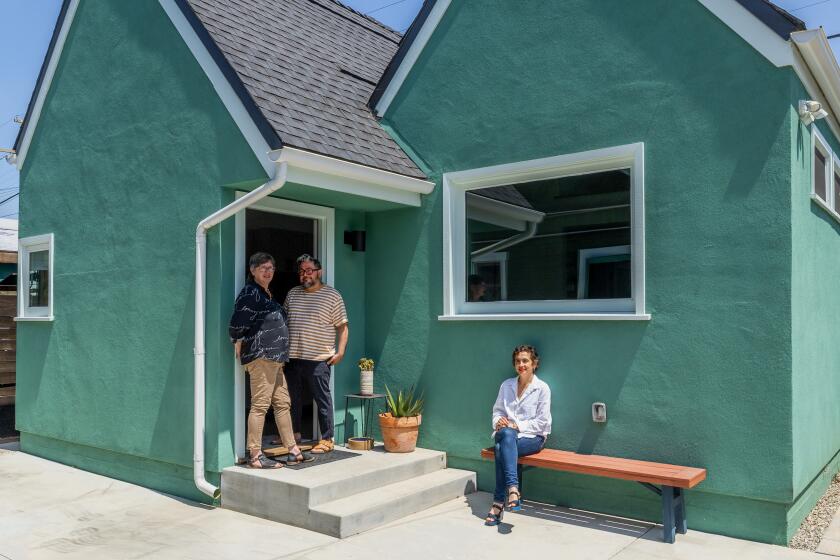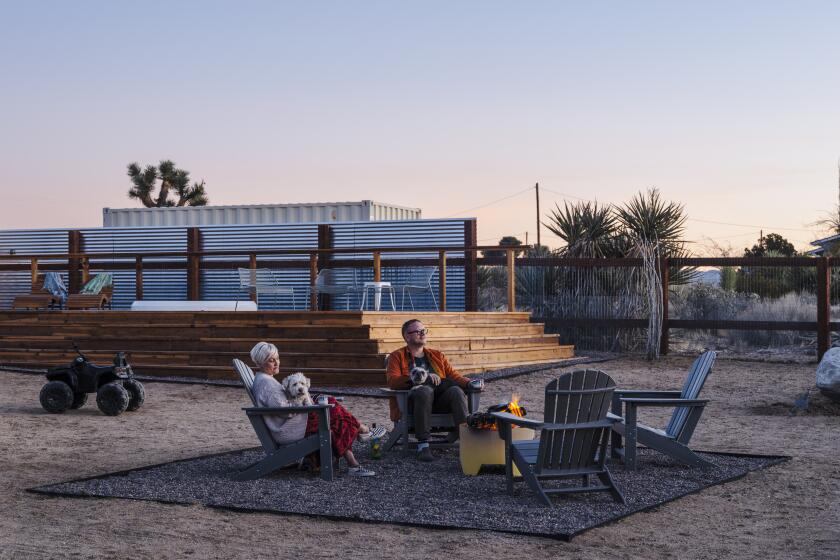A Venice Street Is Named for a Visionary : Abbot Kinney Boulevard honors the spirit of the city’s fanciful founder with an eclectic mix of galleries, studios and street life
Abbot Kinney Boulevard. Never heard of it, you say? And yet you may already have traveled its length.
Since August, West Washington Boulevard in Venice--the stretch of restaurants, antique shops and galleries that links Main Street to Washington Street--has officially been renamed Abbot Kinney Boulevard. For the first time, Venice has a street named for its fanciful founder.
With three roads named Washington in Venice alone, the change was made partly to avoid confusion. But it also lends the street a more fitting cultural profile.
At the turn of the century, Abbot Kinney envisioned his “Venice of America” as a cultural mecca that would attract artists, opera stars and orchestras to the Western beaches--although as his finances fizzled, he set about creating an amusement area instead.
The new Abbot Kinney Boulevard, which cuts through the sometimes tough Oakwood section of Venice, is a bit of both: a cultural oasis that is as motley and bustling as a midway.
Artists have long holed up in studios behind its blanked-out storefronts, and more and more artisans have hung out their shingles.
The boulevard’s galleries--some newcomers, some older pioneers--aren’t highbrow arbiters of current aesthetic developments. Rather, they tend to be as offbeat, community-oriented or culturally diverse as their setting.
Consider the following examples.
SET IN CONCRETE: Visitors to Avenue tend to hesitate at the door, wondering if they are entering a gallery or intruding on some stylish private realm, done completely in shades of gray.
For the past two years, in fact, the storefront has been the studio of artist-designer Susan Murphy, who still tends to sit there, bent over a huge, triangular, glass-topped desk. Two months ago, she opened her studio as a gallery, and is now representing the work of three other artists in addition to her own.
Murphy works in concrete--ranging from a composite variant airy enough for earrings to the hefty structural stuff of buildings--which she molds into custom furniture, fireplaces and fountains. Her business is aptly named Concrete Reality.
Positioned around the gallery are Murphy’s surprisingly delicate vases, fish bowls and other accessories. They are often fashioned of lightweight concrete blocks, ruptured by a sculpted fissure through which a glass bowl or vase is glimpsed.
Alternately, Murphy may wrap concrete around glass or use small-scale industrial girders jutting from a concrete base to hold, say, single flowers. She admits to a very strong Japanese influence.
“I think of myself as an artist, but out of necessity, I’ve become a furniture designer,” Murphy said. “It’s a great way for an artist to make a living. People don’t buy sculpture. But if you’re presenting an art object that’s also functional, people look at it differently.”
Why concrete? Since a friend introduced her to the technique of making lightweight versions of the material six years ago, she has grown to respect concrete’s integrity, its symbolic solidity, even its gray color. She finds, she said, that she has been working with concrete on a larger and heavier scale since then.
“It’s a beautiful, timeless material,” she said. “It’s easy to work with; you can make virtually anything out of it--and it lasts forever.”
Avenue, 1335 1/2 Abbot Kinney Blvd. (213) 396-1114. Open 11 a.m. to 6 p.m. Saturday and Sunday and weekdays by appointment.
RAINBOW ROOM: “It’s a wonderful area--a cross-culture of people live here,” Zeneta Kertisz says of the Abbot Kinney neighborhood. “And you’re able to bounce off everybody.”
Five years ago, Kertisz began parlaying her sense of that mix by opening the Human Art Gallery Studio in the 1,000-square-foot storefront space that adjoins the studio of her husband, artist John Kertisz. She envisioned it, she says, as a “multicultural gallery--a rainbow art gallery--that represents all artists, no matter what color.”
Now on view is “Series I & II: Zip Zap.” It is a show of works by 10 black artists from Los Angeles, although it is not specifically advertised as such. “The only time I deal with color is in art,” Kertisz says. “I also spoke with the artists about it, and they want to be known as artists, not black artists.”
The show is envisioned as a “pre-show” of small-scale works to usher in a second exhibition of larger works by the same artists. Titled “Massive,” the latter will be mounted at the Museum of African-American Art in the May Co. building at Martin Luther King Jr. and Crenshaw boulevards.
Artists whose work is being shown include Joe Ray, Bernard Hoyes and Darrell Evers, who is the son of assassinated civil rights activist Medgar Evers. The 10 artists “work with the black community. They’re very much in touch with that community--and they’ve been around for a long time,” Kertisz said.
The next show at Human Art Gallery Studio will be “California Culture (Uncensored),” an exhibition of assemblage art, primarily by Venice artists.
“The gallery is geared to show the work of artists that larger galleries would not touch,” Kertisz said. “I think that’s really necessary--that new blood is being pumped in.”
“Series I & II: Zip Zap,” through today at the Human Art Gallery Studio, 1319 Abbot Kinney Blvd., Venice. (213) 399-8188. Open 11 a.m. to 5 p.m.
FOLLOW THE DOTS: The Abbot Kinney Gallery, a onetime printer’s shop that is tucked away in a short alley off the main boulevard, will be 1 year old come December. It is a joint venture of artist Ronn Davis, who teaches at USC (and whose work is part of the current show at the Human Art Gallery Studio) and real estate agent Joan Del Monte.
For Del Monte, the decision to open a gallery grew from a feeling that the Abbot Kinney Boulevard area, shot through as it is with artists’ studios and architects’ offices, had a ready audience for more galleries.
“I think you’ll start seeing the little dots coming in,” she said, referring to the gallery indicators on the maps found in local monthly art guides.
The Abbot Kinney Gallery represents a core group of four artists but also plans to stage various group shows. The gallery has further been used for poetry readings by the local group On the Bus and for functions of the Venice Chamber of Commerce.
On view now are pieces by one gallery artist, Del Monte’s husband, Robert, who ran a bronze foundry in Venice until 1975. Working in a variety of styles, Robert Del Monte produces cast-bronze sculptures, brightly colored acrylic-on-paper paintings, and earthenware masks made according to his own version of the Japanese raku technique.
The masks, Robert Del Monte said, are “about attitudes.” But a local resident who wandered into the gallery may have described them better. “He told me, ‘That’s what’s under the skin of most human beings,’ ” Del Monte said.
Robert Del Monte through Saturday at the Abbot Kinney Gallery, 1415 1/2 Abbot Kinney Blvd., Venice. (213) 396-9262. Open Wednesday through Saturday, 1 to 5 p.m.



